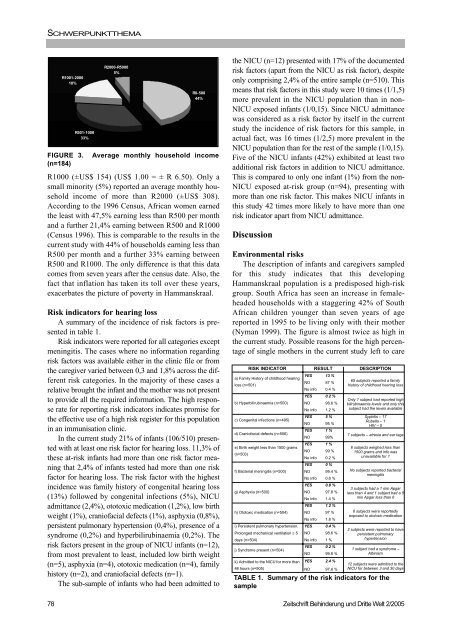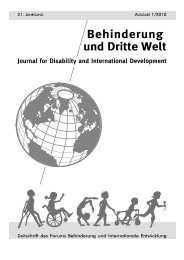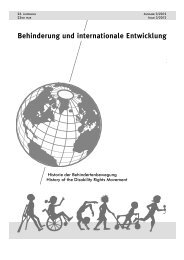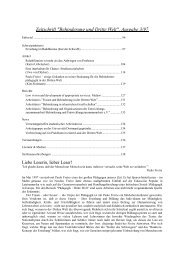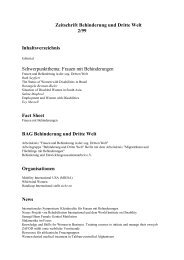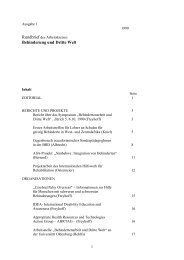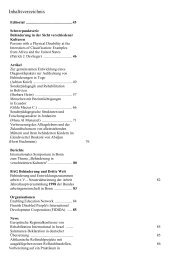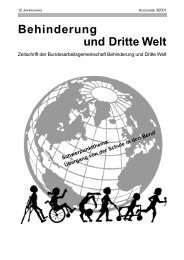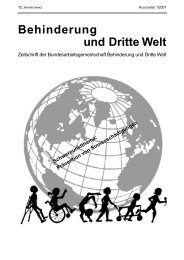Armut und Behinderung - Behinderung und Dritte Welt
Armut und Behinderung - Behinderung und Dritte Welt
Armut und Behinderung - Behinderung und Dritte Welt
Create successful ePaper yourself
Turn your PDF publications into a flip-book with our unique Google optimized e-Paper software.
SCHWERPUNKTTHEMAR1000 (±US$ 154) (US$ 1.00 = ± R 6.50). Only asmall minority (5%) reported an average monthly householdincome of more than R2000 (±US$ 308).According to the 1996 Census, African women earnedthe least with 47,5% earning less than R500 per monthand a further 21,4% earning between R500 and R1000(Census 1996). This is comparable to the results in thecurrent study with 44% of households earning less thanR500 per month and a further 33% earning betweenR500 and R1000. The only difference is that this datacomes from seven years after the census date. Also, thefact that inflation has taken its toll over these years,exacerbates the picture of poverty in Hammanskraal.Risk indicators for hearing lossA summary of the incidence of risk factors is presentedin table 1.Risk indicators were reported for all categories exceptmeningitis. The cases where no information regardingrisk factors was available either in the clinic file or fromthe caregiver varied between 0,3 and 1,8% across the differentrisk categories. In the majority of these cases arelative brought the infant and the mother was not presentto provide all the required information. The high responserate for reporting risk indicators indicates promise forthe effective use of a high risk register for this populationin an immunisation clinic.In the current study 21% of infants (106/510) presentedwith at least one risk factor for hearing loss. 11,3% ofthese at-risk infants had more than one risk factor meaningthat 2,4% of infants tested had more than one riskfactor for hearing loss. The risk factor with the highestincidence was family history of congenital hearing loss(13%) followed by congenital infections (5%), NICUadmittance (2,4%), ototoxic medication (1,2%), low birthweight (1%), craniofacial defects (1%), asphyxia (0,8%),persistent pulmonary hypertension (0,4%), presence of asyndrome (0,2%) and hyperbilirubinaemia (0,2%). Therisk factors present in the group of NICU infants (n=12),from most prevalent to least, included low birth weight(n=5), asphyxia (n=4), ototoxic medication (n=4), familyhistory (n=2), and craniofacial defects (n=1).The sub-sample of infants who had been admitted to78R1001-200018%R501-100033%R2000-R50005%R0-50044%FIGURE 3. Average monthly household income(n=184)the NICU (n=12) presented with 17% of the documentedrisk factors (apart from the NICU as risk factor), despiteonly comprising 2,4% of the entire sample (n=510). Thismeans that risk factors in this study were 10 times (1/1,5)more prevalent in the NICU population than in non-NICU exposed infants (1/0,15). Since NICU admittancewas considered as a risk factor by itself in the currentstudy the incidence of risk factors for this sample, inactual fact, was 16 times (1/2,5) more prevalent in theNICU population than for the rest of the sample (1/0,15).Five of the NICU infants (42%) exhibited at least twoadditional risk factors in addition to NICU admittance.This is compared to only one infant (1%) from the non-NICU exposed at-risk group (n=94), presenting withmore than one risk factor. This makes NICU infants inthis study 42 times more likely to have more than onerisk indicator apart from NICU admittance.DiscussionEnvironmental risksThe description of infants and caregivers sampledfor this study indicates that this developingHammanskraal population is a predisposed high-riskgroup. South Africa has seen an increase in femaleheadedhouseholds with a staggering 42% of SouthAfrican children younger than seven years of agereported in 1995 to be living only with their mother(Nyman 1999). The figure is almost twice as high inthe current study. Possible reasons for the high percentageof single mothers in the current study left to careRISK INDICATOR RESULT DESCRIPTIONa) Family History of childhood hearingYES 13 %loss (n=501)NO 87 %No info 0.4 %b) Hyperbilirubinaemia (n=500)c) Congenital infections (n=495)d) Craniofacial defects (n=506)e) Birth weight less than 1500 grams(n=503)f) Bacterial meningitis (n=500)g) Asphyxia (n=500)h) Ototoxic medication (n=504)i) Persistent pulmonary hypertension.YES 0.2 %NO 98.6 %No info 1.2 %YES 5 %NO 95 %YES 1 %NO 99%YES 1 %NO 99 %No info 0.2 %YES 0 %NO 99.4 %No info 0.6 %YES 0.8 %NO 97.8 %No info 1.4 %YES 1.2 %NO 97 %No info 1.8 %YES 0.4 %Prolonged mechanical ventilation ≥ 5 NO 98.6 %days (n=504) No info 1 %j) Syndrome present (n=504)YES 0.2 %NO 99.8 %k) Admitted to the NICU for more than YES 2.4 %48 hours (n=505) NO 97.6 %65 subjects reported a familyhistory of childhood hearing lossOnly 1 subject had reported highbilirubinaemia levels and only thissubject had the levels availableSyphilis – 17Rubella – 1HIV – 57 subjects – atresia and ear tags6 subjects weighed less than1500 grams and info wasunavailable for 1No subjects reported bacterialmeningitis3 subjects had a 1 min Apgarless than 4 and 1 subject had a 5min Apgar less than 66 subjects were reportedlyexposed to ototoxic medication2 subjects were reported to havepersistent pulmonaryhypertension1 subject had a syndrome –Albinism12 subjects were admitted to theNICU for between 3 and 30 daysTABLE 1. Summary of the risk indicators for thesampleZeitschrift <strong>Behinderung</strong> <strong>und</strong> <strong>Dritte</strong> <strong>Welt</strong> 2/2005


